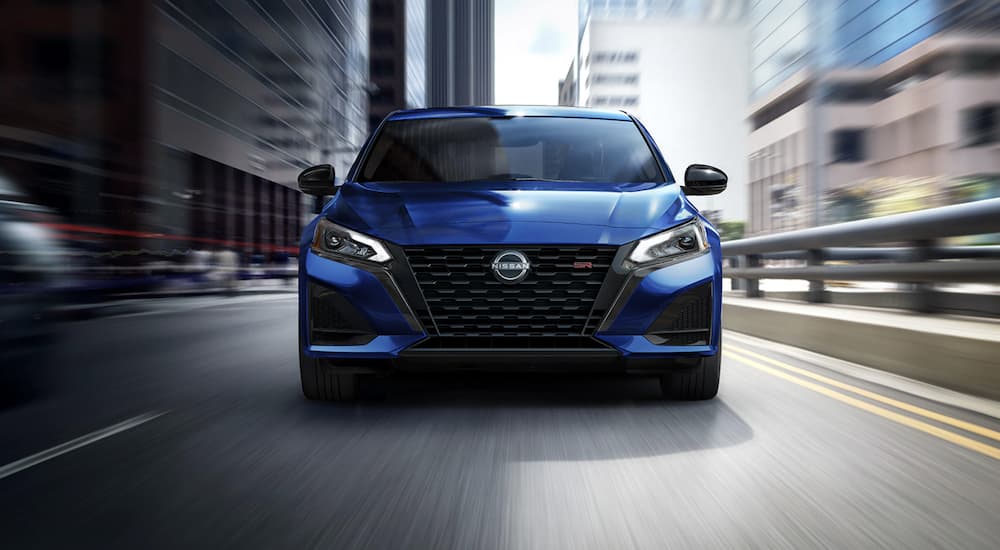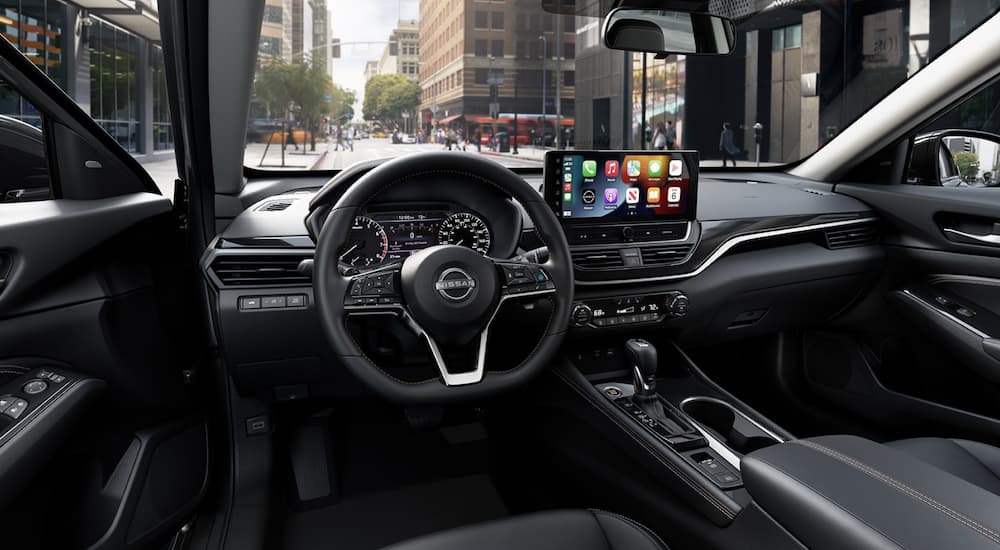The Nissan Altima is a common sight on the road today, with the 2023 Nissan Altima bringing both style and durability to drivers looking for something smaller than the Maxima but a little roomier than a Sentra. Mid-size sedans have long been popular with drivers looking for a long-lasting, durable car at a great value, and the Nissan Altima has dominated this market for almost thirty years.
Since its release in the early 1990s, the Altima has remained an understated sedan that never fails to impress when it comes to delivering reliable performance, hence why it continues to be so popular among commuters and families even decades after its introduction. Now in its sixth generation, the Altima continues to receive modern upgrades that help keep it popular in the mid-size sedan market. Drivers looking for a practical and comfortable ride can pick up an Altima and feel confident it will get them where they need to go.
A Name Within a Name (Within a Name)
The story of the Altima doesn’t begin in the 1990s. The Altima was first sold as the Stanza Altima, but as it came into its own, Nissan quickly dropped the Stanza name and let the Altima stand on its own. But before it was even known as the Stanza Altima, it began as an offspring of what was called Nissan’s Bluebird Line. This lineup stretched back decades, starting with Nissan’s 1957 Bluebird. Never heard of it? It’s actually one of the longest-running nameplates in the Nissan family.
Anyone that knows Nissan knows the company is a master at creating some of the most functional, affordable, and interesting cars on the road. The automaker has a history of strange and unique vehicles going back almost ninety years. While we might not recognize the Nissan Bluebird name today, the nameplate is still in use in Japan as the Bluebird Sylphy plus marketed in mainland China simply as the Nissan Bluebird.
Like most good things, the Bluebird was developed out of necessity. Back in the late 1950s, Nissan needed a mid-size compact car to compete with the likes of the Toyota Corona. Not only was the mid-size Bluebird offered as a sedan, but it was also offered as an option for Taxi drivers, a demographic the Corona was also marketed to. As it was exported across the globe, it took on several name variations, the most notable being the Datsun Bluebird and Nissan Pintara. The somewhat complicated name change history came to a conclusion when it reached North American shores as the Nissan Stanza, which transformed into the definitive Altima name in 1993.
The Bluebird line is known for spawning some of Nissan’s most well-known models. For example, the sporty S130 Fairlady Z later morphed into the Maxima, which received several name changes like the 910 Bluebird and the S130 Fairlady Z. Much like the Maxima, the Altima’s name evolution demonstrated Nissan’s continued refinement of the model leading it to become the iconic sedan it is today. Once the retitling was complete, the Altima became an exclusive model in the American market, and its sedan-hungry consumers welcomed it with open arms.
However, the Altima wasn’t technically the first of the Bluebird line to reach foreign shores. While the Bluebird name officially made its debut in 1959, records show it was first used in 1957 for Nissan’s original 210 series, which was sold in the United States as the Datsun 1000, the first Nissan sold in America and perhaps the true origin of the Altima. While the name progression is admittedly…confusing, the real evolution began when Nissan began modifying the Bluebird in the following decade.
Hip To Be Square
By the swinging Sixties, Nissan refreshed the Bluebird with modern square angles popular in cars at the time. A 2-door sedan was added to the already available 4-door and 5-door wagon options, giving drivers more flexibility when choosing the right model for their lifestyle. However, American drivers would have limited choices since the 2-door option was never offered in the US. On top of this, a 2-door coupe was added to the Bluebird range in the late 1960s, adding to the line’s diversity.
Even though the 2-door SS model wasn’t offered on US shores, that didn’t dampen its popularity. Nissan reworked the sedan giving it a larger 1.6L engine and renaming it the SSS in 1965. This model remained in production from the 1960s up till 2001. The Bluebird line proved popular, increasing both Nissan’s brand name and sales, with the most popular Bluebird to be sold being the 510. Because of this, the 510 was recycled and put on the late 1970s Nissan Stanza, which were sold in America, despite the 510 and Stanza being completely different vehicles.
Throughout the 1970s, Nissan continued to adjust and grow the Bluebird line with various models, including the Bluebird-U and 610, which eventually took the place of the 510. With options like a hardtop, 2, 4, or 5 door, plus several trim levels, the 610 was popular with drivers both domestic and internationally. Besides Japan, America was the only country to see the 610 HT, which featured six-bulb tail lights. Because of the light design, this required license plates to be placed below the back bumper, making the model stand out from the other 610s that were available in countries like Europe and Australia.
The Altima Makes Its Debut (Finally)
So, where does the Altima come into all this? When a car company like Nissan plays the name game, it can be tough to trace a car back to its origins. The name “Altima” has jumped around a few times on Nissan models before being applied to the current incarnation in the United States. The first time Nissan used the Altima title was originally applied to a trim level of the Nissan Laurel, a sedan sold in the Caribbean and Central America. After that, the Altima came to the States, creating the Stanza Altima.
Not long after the Stanza Altima was released, it was redesigned and sold as just the Altima, an understated but rugged little sedan reminiscent of the boxy Honda Accord. In 1999, the Altima received a refresh and became exclusive to North American car buyers. Since then, the Altima has gone under the radar, often overshadowed by brighter, louder sedans; however, that didn’t stop the Altima from becoming a go-to practical car for drivers looking for utility and reliability over flash. The Altima continues to quietly remain one of Nissan’s best-kept secrets, often topping best-selling charts when it comes to reliability, affordability, and safety.
Here to Stay
Even today, Nissan continues to revamp the Altima. Newer changes in the past years include exchanging its regular V6 engine with a turbocharged 2.0L engine to increase performance. It also made design changes to make the model slightly larger with more cabin space, as well as an upgrade on the latest safety and tech features.
While the Altima isn’t ever going to be the flashiest vehicle on the road, that was never the goal. Altima drivers know their Altima will carry both themselves and their families from school to work and home again, all without worry. When it comes to having peace of mind when you’re behind the wheel, the Alima delivers in every way, and it has a long history to back it up.






